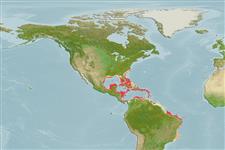>
Ovalentaria/misc (Various families in series Ovalentaria) >
Opistognathidae (Jawfishes)
Etymology: Opistognathus: Greek, opisthe = behind + Greek, gnathos = jaw (Ref. 45335); to the very elongate upper jaw of the type species of the genus, Opistognathus nigromarginatus (Ref. 128653).
More on authors: Jordan & Thompson.
Environment: milieu / climate zone / depth range / distribution range
पारिस्थितिकी
समुद्री प्रवाल-भित्ति संयुक्त; गहराई सीमा 3 - 40 m (Ref. 9710), usually 3 - 40 m (Ref. 27115). Tropical; 22°C - 28°C (Ref. 27115); 32°N - 23°S, 100°W - 29°W
Western Central Atlantic: southern Florida, USA and Bahamas to Barbados and northern South America.
आकार / वज़न / Age
Maturity: Lm ? range ? - ? cm
Max length : 10.0 cm TL पुल्लिंग / अलिंग; (Ref. 7251)
Short description
आकृति विज्ञान | मौरफोमैटरिक्स
पृष्ठीय रीढ़ (सम्पूर्ण): 11; पृष्ठीय सौफट रेज़ (सम्पूर्ण): 15-16; गुदा कांटा 3; ऐनल सौफट रेज़: 14 - 15. Body light bluish gray with numerous pale blue dots; head, nape and anterior part of dorsal fin yellow; a pair of black spots often present on chin (Ref. 13442).
Inhabit burrows made of crushed coral or sand. Hovers vertically, above or near its hole. The male courts the female by swimming in an arched position with his fins spread towards her (Ref. 9710). Male broods the eggs orally (Ref. 5521). Has been reared in captivity (Ref. 35427).
Life cycle and mating behavior
परिपक्व अवधि | पुनरुत्पत्ति | मछलीऔ का अंडे देना | अंडे | Fecundity | लार्वा
Mouthbrooders. Eggs which are clumped together in a sticky ball get incubated inside the male's mouth (Ref. 5521). Monogamous mating is observed irrespective of resource abundance (Ref. 52884).
Robins, C.R. and G.C. Ray, 1986. A field guide to Atlantic coast fishes of North America. Houghton Mifflin Company, Boston, U.S.A. 354 p. (Ref. 7251)
IUCN Red List Status (Ref. 130435)
Threat to humans
Harmless
Human uses
जलजीवालय: व्यापारिक
अधिक जानकारी
Age/Sizeबाढ़Length-weightLength-lengthLength-frequenciesमौरफोमैटरिक्सआकृति विज्ञानलार्वालारवल गतिकीभर्तीबहुतायतBRUVS
संदर्भजलीयकृषिजलीयकृषि रूपरेखाखींचआनुवंशिकीElectrophoresesहैरेटिबिलटीबीमारीप्रक्रमणNutrientsMass conversion
सहयोगीयोतस्वीरेStamps, Coins Misc.ध्वनिसिगुयटिरारफ्तारतैरने के प्रकारगिल क्षेत्रOtolithsदिमागदृष्टि
साधन
Special reports
Download XML
इंटरनेट स्रोत
Estimates based on models
Preferred temperature (Ref.
123201): 24.7 - 28, mean 27 °C (based on 402 cells).
Phylogenetic diversity index (Ref.
82804): PD
50 = 0.5000 [Uniqueness, from 0.5 = low to 2.0 = high].
Bayesian length-weight: a=0.00389 (0.00180 - 0.00842), b=3.12 (2.94 - 3.30), in cm total length, based on all LWR estimates for this body shape (Ref.
93245).
Trophic level (Ref.
69278): 3.0 ±0.1 se; based on diet studies.
Fishing Vulnerability (Ref.
59153): Low vulnerability (10 of 100).
Nutrients (Ref.
124155): Calcium = 127 [66, 225] mg/100g; Iron = 0.86 [0.51, 1.48] mg/100g; Protein = 17.9 [16.7, 19.0] %; Omega3 = 0.0953 [, ] g/100g; Selenium = 28.1 [12.6, 60.7] μg/100g; VitaminA = 222 [67, 762] μg/100g; Zinc = 2.13 [1.39, 3.07] mg/100g (wet weight);
